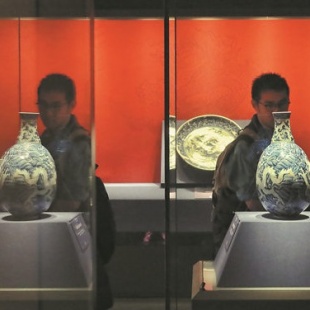Artworks fit for royalty


This exhibition showcases some of the items that were not commonly passed down through history.
"Due to a very strict selection system, any items with even slight imperfections during the production process would not be sent to the royal family. They would be smashed on the spot and not allowed to reach the public," Zhang says. "Therefore, through the excavation of the kiln site … many items were restored. Among them were some shapes never seen before," she adds.
A large dish featuring two parrots perching on tree branches with peaches and flowers is front and center.
The parrots were regarded by the ancients as auspicious birds — their Chinese name yingwu sounds similar to bravery and strength. The parrot motif appeared as early as the Tang Dynasty (618-907).
"The dish has a diameter of over 70 centimeters, quite rare among porcelain items produced by the imperial kiln, making it particularly impressive. The design is also distinctive, with a motif of a parrot pecking at a peach, adding to its unique charm," Zhang explains.
The exhibition has also incorporated elements of the museum's garden scenery into its design to highlight the porcelain items.
For example, one can see green-glazed porcelain parrots placed among the rocks and hills in miniature garden-inspired landscapes.
Crossing a few courtyards, polychromatic New Year paintings printed off the carved woodblocks are striking with their strong contrast of colors and rich, detail-charged patterns, offering a deeper look into the essence of traditional Chinese culture.
New Year paintings are an ancient folk art popular across the country, which evolved from an early reverence for nature and belief in deities into an important folk art form used to ward off evil, seek blessings, celebrate festivals, and decorate daily life.
Huo Qingshun, an inheritor of the Yangliuqing New Year paintings, a national-level intangible cultural heritage, demonstrates the printing process at the museum.
The content of the art form covers five themes — including children, folk customs and stories, and deities, says Huo from Tianjin, who has practiced the art for more than six decades.
"They mostly carry auspicious meanings like wealth and prosperity, family harmony and fertility, and peace and safety," Huo says.
It takes five steps to pull off a painting, from sketching a design on paper and carving it into wooden blocks to hand-painting and mounting.
"Each step is something you learn throughout your life, so in practice, it's a collective effort — usually done by five people," Huo says.





































